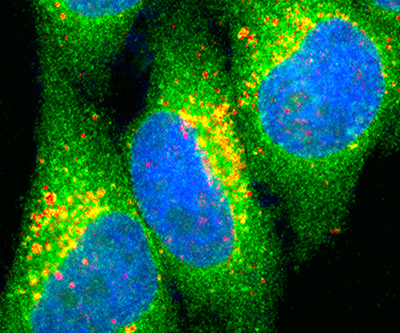
mTor (green) colocalizes on lysosomes with Lamp1 (red) in RagA knockdown, Wdr24 knockout HeLa cells.
Credit: Lilly Lab, NICHD/NIH
Cells use highly coordinated pathways to sense and adapt to their environment. For example, cells must change their metabolism when nutrients are not available. They switch from an active growth phase to a catabolic phase that breaks down existing sources of energy. A complex called TORC1 integrates various signals to control cell growth, proliferation, and cell death.
The Lilly Lab uses Drosophila, or fruit flies, as a model organism to study how TORC1 integrates environmental and developmental signals, especially in the process of oogenesis—the formation of female gametes or eggs.
Work from the lab shed light on a longstanding question of how a protein called Tuberous Scleroisis Complex, or TSC, blocks the activity of TORC1. One model suggests that TSC works exclusively downstream of a growth factor signaling pathway called PI3K-AKT. A different model suggests that TSC works downstream of both growth factor signaling and amino acid sensing pathways, meaning it’s regulated by growth factors and nutrient sensors.
A study from the lab describes a unified model of TORC1 regulation that supports the latter theory. The team focused on a nutrient sensor called Rag GTPase and how it controls TSC by regulating whether TSC is activated by lysosomes. The lab found that the Rag GTPase, which was previously thought to function exclusively in amino acid sensing, also regulates the recruitment of TSC to lysosomes in response to growth factor restriction.
The findings support a model in which both the amino acid sensing and growth factor signaling pathways use the Rag GTPase to inhibit TORC1 activity by regulating TSC lysosomal dynamics. Clarifying the roles of these molecular switches will enable researchers to better understand what goes awry in adverse situations, including miscarriage and congenital anomalies.
Learn more about the Cell and Structural Biology Group: https://www.nichd.nih.gov/about/org/dir/affinity-groups/CSB.
 BACK TO TOP
BACK TO TOP